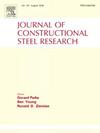碳钢-混凝土-铝合金圆形复合柱轴压力学性能研究
IF 4
2区 工程技术
Q1 CONSTRUCTION & BUILDING TECHNOLOGY
引用次数: 0
摘要
为评价碳钢-混凝土-铝合金圆形组合柱的轴压性能,进行了8个试件的轴压试验,试验参数主要包括截面直径、混凝土类型(普通混凝土和轻量化混凝土)、铝合金管壁厚。分析了试件的破坏模式、荷载-应变曲线、侧向变形系数和荷载-轴向位移曲线,阐明了试验参数变化对试件承载力、轴压刚度和延性的影响。利用ABAQUS建立全尺寸有限元模型,研究典型试件的应力分布。分析总结了各参数变化对轴压力学性能指标的影响程度及规律,提出了圆形碳钢-混凝土-铝合金复合柱轴压强度的确定公式。研究结果表明:在轴压荷载作用下,试件各构件的变形是一致的。截面尺寸的变化对轴压力学性能指标影响显著,当截面尺寸分别从200 mm增大到300 mm和400 mm时,普通混凝土(轻量化混凝土)和夹层混凝土试件的承载力分别提高了135.9%和329.3%(分别提高了91.6%和204.7%),轴压刚度分别提高了1.93倍和9.14倍(分别提高了1.69倍和8.0倍);塑性分别下降30.3%和38.4%(33.3%和40.1%)。通过有限元模拟发现,在达到极限承载力之前,铝合金管与夹芯混凝土之间几乎没有相互作用,而钢管与夹芯混凝土之间的接触应力随着轴向位移的增加而逐渐增大,说明钢管对夹芯混凝土具有良好的约束作用。根据钢管混凝土结构技术规范提出的承载力计算方法,引入组合强度影响系数,可以合理预测圆形碳钢-混凝土-铝合金复合柱的轴压承载力。本文章由计算机程序翻译,如有差异,请以英文原文为准。
Study on axial compression mechanical properties of circular carbon steel-concrete‑aluminum alloy composite columns
To evaluate the axial compression performance of circular carbon steel-concrete‑aluminum alloy composite columns, the axial compression test of 8 specimens was carried out, the parameters involved in the test mainly included the cross-sectional diameter, concrete type (normal concrete and lightweight concrete), and the wall thickness of the aluminum alloy tube. Subsequently, the failure modes, load-strain curves, lateral deformation coefficients, and load-axial displacement curves of the specimens were analyzed, clarifying the influence of variations in experimental parameters on bearing capacity, axial compression stiffness, and ductility. A full-scale finite element model was established by using ABAQUS to study the stress distribution of typical specimens. The influence degree and rules of various parameter changes on the axial compression mechanical performance indicators were analyzed and summarized, and furthermore, the equation for determining axial compressive strength for circular carbon steel-concrete‑aluminum alloy composite columns was proposed. The research results show that the deformation of components of specimen is consistent under axial compression load. The change in cross-sectional size have a notable effect on the axial compression mechanical performance indicators, when the cross-sectional size increases from 200 mm to 300 mm and 400 mm respectively, the bearing capacity of specimens with normal concrete (lightweight concrete) as sandwich concrete increases by 135.9 % and 329.3 % (91.6 % and 204.7 %), the axial compression stiffness increases by 1.93 times and 9.14 times (1.69 times and 8.0 times), and the ductility decreases by 30.3 % and 38.4 % (33.3 % and 40.1 %) respectively. Through conducting simulations with finite elements, the finding is that before reaching the ultimate bearing capacity, there is almost no interaction between the aluminum alloy tube and the sandwich concrete, while the contact stress between the steel tube and the sandwich concrete gradually increases with the increase of axial displacement, suggesting that the steel tube exerts a good confinement influence on the sandwich concrete. The calculation method of bearing capacity proposed based on the technical specifications for concrete-filled steel tubular structures and the introduction of the combined strength influence coefficient can reasonably predicted the axial compression bearing capacity of circular carbon steel-concrete‑aluminum alloy composite columns.
求助全文
通过发布文献求助,成功后即可免费获取论文全文。
去求助
来源期刊

Journal of Constructional Steel Research
工程技术-工程:土木
CiteScore
7.90
自引率
19.50%
发文量
550
审稿时长
46 days
期刊介绍:
The Journal of Constructional Steel Research provides an international forum for the presentation and discussion of the latest developments in structural steel research and their applications. It is aimed not only at researchers but also at those likely to be most affected by research results, i.e. designers and fabricators. Original papers of a high standard dealing with all aspects of steel research including theoretical and experimental research on elements, assemblages, connection and material properties are considered for publication.
 求助内容:
求助内容: 应助结果提醒方式:
应助结果提醒方式:


